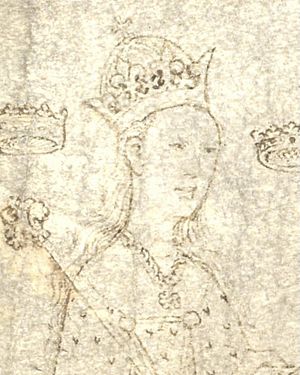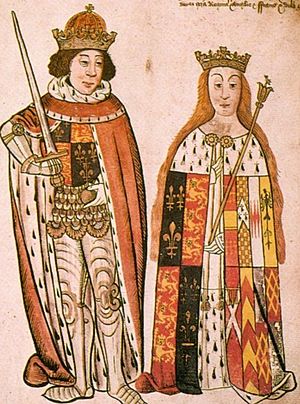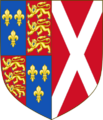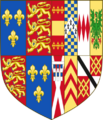Anne Neville facts for kids
Quick facts for kids Anne Neville |
|
|---|---|

Drawing from the Rous Roll, c. 1483
|
|
| Queen consort of England | |
| Tenure | 26 June 1483 – 16 March 1485 |
| Coronation | 6 July 1483 |
| Born | 11 June 1456 Warwick Castle, Warwickshire, England |
| Died | 16 March 1485 (aged 28) Westminster, London, England |
| Burial | 25 March 1485 Westminster Abbey, London, England |
| Spouse |
|
| Issue | Edward of Middleham, Prince of Wales |
| House | Neville |
| Father | Richard Neville, 16th Earl of Warwick |
| Mother | Anne Beauchamp, 16th Countess of Warwick |
Anne Neville (born June 11, 1456 – died March 16, 1485) was a Queen of England. She was the wife of King Richard III. Anne was the younger of two daughters of Richard Neville, 16th Earl of Warwick, who was known as the "Kingmaker."
Before marrying Richard III, Anne was the Princess of Wales. This was because she was married to Edward of Westminster, Prince of Wales. He was the only son of King Henry VI.
Anne was part of the powerful House of Neville. She played a big role in the Wars of the Roses. These were battles between the House of York and the House of Lancaster. They fought for control of the English throne. Anne's father arranged for her to marry Prince Edward. This marriage was meant to create an alliance with the House of Lancaster. It was also hoped to stop the civil war.
After Prince Edward died, Anne married Richard, Duke of Gloucester. He was the younger brother of King Edward IV. Richard was also Anne's cousin. Anne became queen when Richard became king in June 1483. This happened after Edward IV's children were declared not rightful heirs. Anne died five months before her husband, in March 1485. Her only child, Edward of Middleham, died before her.
Contents
Anne Neville's Early Life

Anne Neville was born at Warwick Castle. She was the younger daughter of Richard Neville, 16th Earl of Warwick. Her mother was Anne de Beauchamp. Her father was one of the most powerful nobles in England. He was a key supporter of the House of York. Anne's great-aunt, Cecily Neville, was the mother of Richard, Duke of York. He claimed the crown for the House of York.
Anne spent much of her childhood at Middleham Castle. This was one of her father's properties. There, she and her older sister, Isabel, met two younger sons of the Duke of York. These were Richard, Duke of Gloucester (who became Richard III), and George, Duke of Clarence. Richard trained at Middleham Castle from 1461 to 1468. It is thought that even then, a marriage between the Earl's daughters and the young dukes was considered.
The Duke of York died in 1460. But with Warwick's help, his oldest son became King Edward IV in 1461. In 1469, Isabel married Clarence. In 1470, Anne Neville was promised to Edward of Westminster. He was the Lancastrian heir to the throne. They married by the end of that year.
Becoming Princess of Wales
The Earl of Warwick had disagreements with Edward IV. He did not like how much power the new queen's family, the Woodvilles, gained. In 1469, Warwick tried to make his son-in-law George king. But Parliament did not agree. After another rebellion failed in 1470, Warwick had to flee to France. There, he joined forces with the House of Lancaster.
King Henry VI was imprisoned. So, his wife, Margaret of Anjou, was the leader of the Lancastrians. She was careful about Warwick's plans. To show his loyalty, Anne Neville was formally promised to Prince Edward. He was the son of Henry VI and Margaret of Anjou. They married in Angers Cathedral, France, likely on December 13, 1470. This made Anne Neville the Princess of Wales.
Warwick helped Henry VI become king again in October 1470. However, Edward IV returned to England in March 1471. He quickly took London and captured Henry VI. Henry VI was taken as a prisoner to the Battle of Barnet. Warwick was killed there on April 14, 1471. Edward IV then put Henry VI in the Tower of London. After the Yorkists won the Battle of Tewkesbury on May 4, Henry was said to have died of sadness. Some reports suggest Richard, Duke of Gloucester, was involved in his death.
Margaret of Anjou had returned to England with Anne Neville and Prince Edward in April. They brought more soldiers. At the Battle of Tewkesbury, Edward IV defeated this last Lancastrian army. Prince Edward was killed during or soon after the battle. Anne Neville was taken prisoner. She was first taken to Coventry. Then she went to her brother-in-law, the Duke of Clarence's house in London. Her mother, Anne Beauchamp, found safety in Beaulieu Abbey.
Anne was now a widow. She became a point of disagreement between George of Clarence and his brother Richard of Gloucester. Richard still wanted to marry her. Anne Neville and her sister were heirs to their parents' large estates. Clarence wanted all the inheritance. He treated Anne as his ward and did not want her to marry. This would make it harder for her to claim her share.
There are stories that Clarence hid Anne in a London shop. He disguised her as a servant so Richard would not find her. But Richard is said to have found her. He took her to a safe place at the Church of St Martin's le Grand. To get George's permission for the marriage, Richard gave up most of Warwick's land and property. This included the earldoms of Warwick and Salisbury. He also gave Clarence the important job of Great Chamberlain of England.
Duchess of Gloucester
The exact date Anne Neville married Richard, Duke of Gloucester, is not known. Most sources say it happened in late spring or early summer of 1472. The ceremony took place in St Stephen's Chapel in the Palace of Westminster. They received special permission to marry on April 22, 1472. This was needed because Anne had been married to Edward of Lancaster, who was Richard's cousin.
The couple lived at Middleham Castle, Yorkshire. Richard was made Governor of the North by the king. After her marriage, Anne was called Duchess of Gloucester. They had only one child, Edward. He was born at Middleham, likely in 1476. Anne's mother, the dowager Countess of Warwick, joined her daughter's home in 1473. Richard had gotten the king's permission to release his mother-in-law from her protected sanctuary.
In 1478, Anne Neville inherited the Lordship of Glamorgan. This title had belonged to her father. After his death, it went to Anne's older sister Isabel Neville. Women could not hold the Lordship on their own. So the title immediately went to Isabel's husband, George Plantagenet, 1st Duke of Clarence. When he died in February 1478, the title passed to Anne. Her husband, Richard of Gloucester, then held it until his death. After that, it went to the new king, Henry VII.
Becoming Queen of England
On April 9, 1483, Edward IV died. Anne's husband Richard was named Lord Protector. This meant he would rule for his 12-year-old nephew Edward V. But on June 25, 1483, Edward V and his siblings were declared not rightful heirs. Richard then became King Richard III.
Anne Neville was crowned alongside her husband on July 6, 1483. This was done by Thomas Bourchier, the Archbishop of Canterbury. It was the first joint coronation in England in 175 years. Almost all the nobles of England were there. It was a grand event. Richard and Anne's son, Edward of Middleham, was made Prince of Wales. This happened in York Minster on September 8, 1483.
Anne got along well with her mother-in-law, Cecily Neville, Duchess of York. They talked about religious books together.
Edward of Middleham died suddenly in April 1484 at Middleham Castle. His parents were traveling to visit him. Both Richard and Anne were very sad about this news. Anne was especially heartbroken. She became very ill just a few months later.
After her son died, Anne Neville took care of her nephew Edward, Earl of Warwick. After Anne Neville died, Richard may have named another nephew, John de la Pole, Earl of Lincoln, as his next heir.
Death of Anne Neville
Anne Neville died on March 16, 1485. She likely died from tuberculosis. On the day she died, there was an eclipse. Some people thought this was a sign of bad things to come for her husband. She was buried in Westminster Abbey. Her grave was unmarked, to the right of the High Altar. Richard III is said to have cried at her funeral.
However, rumors spread that Richard III had poisoned her. People thought he did this to marry his niece Elizabeth of York. Richard sent Elizabeth away from court. He publicly denied these rumors on March 30, 1485. He spoke to a group of Lords. He said he was very sad about his wife's death. He also said he never thought about marrying in such a way. There is no real reason to believe Richard was not truly sad about his wife's death.
Documents found later show that Richard's ambassadors were sent to Portugal. They were to arrange a double marriage. Richard would marry the Portuguese king's sister Joanna. Elizabeth of York would marry Joanna's cousin Duke Manuel.
There was no memorial for Queen Anne until 1960. A bronze tablet was put on a wall near her grave by the Richard III Society.
Cultural Depictions

Anne Neville appears in plays and books. She is a character in William Shakespeare's play Richard III. In the play, Richard III convinces her to marry him. She also appears as a ghost to Richard III.
Many actresses have played Anne Neville in films and TV shows. These include Claire Bloom, Kristin Scott Thomas, and Winona Ryder. She is also a main character in several historical novels. These books tell fictional stories about her life.
Images for kids
See also
 In Spanish: Ana Neville para niños
In Spanish: Ana Neville para niños





